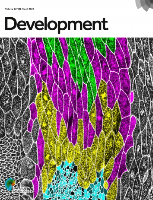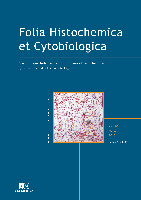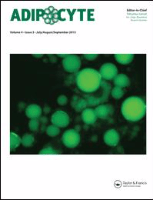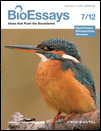
JOURNAL OF MOLECULAR HISTOLOGY
Scope & Guideline
Pioneering the intersection of science and medicine.
Introduction
Aims and Scopes
- Molecular Mechanisms in Disease:
Research that investigates the molecular pathways involved in various diseases, including cancer, neurodegenerative disorders, and metabolic diseases, focusing on how these pathways affect histological and cellular changes. - Histopathological Studies:
Studies that provide insights into the histological alterations associated with different diseases, utilizing advanced techniques such as immunohistochemistry, electron microscopy, and histochemical staining. - Tissue Regeneration and Repair:
Research exploring the molecular and cellular mechanisms underlying tissue regeneration and repair processes, including the role of stem cells and growth factors. - Drug Development and Therapeutics:
Investigations into the effects of pharmacological agents on tissue morphology and function, including studies on drug resistance mechanisms and therapeutic strategies for various conditions. - Environmental and Toxicological Impacts:
Studies examining the effects of environmental toxins and stressors on tissue morphology and function, contributing to our understanding of how these factors influence health and disease.
Trending and Emerging
- Autophagy and Cell Survival Mechanisms:
An increasing number of studies are focusing on the role of autophagy in cellular responses to stress and injury, particularly in cancer and neurodegenerative diseases, reflecting a growing interest in the molecular mechanisms of cell survival. - Cancer Immunology and Microenvironment:
Research exploring the interactions between tumor cells and their microenvironment, including immune cell infiltration and signaling pathways, is gaining traction, indicating a heightened focus on the tumor microenvironment's role in cancer progression. - Stem Cell Research and Regenerative Medicine:
There is a rising trend in studies investigating the potential of stem cells for tissue repair and regeneration, with a focus on their molecular mechanisms and applications in regenerative therapies. - Environmental Health and Toxicology:
An emerging theme is the impact of environmental factors on cellular and molecular changes in tissues, particularly in the context of diseases related to exposure to toxins and pollutants. - Bioinformatics and Systems Biology Approaches:
The integration of bioinformatics and systems biology into histological research is becoming more prominent, allowing for a comprehensive understanding of molecular interactions and pathways involved in health and disease.
Declining or Waning
- Traditional Histological Techniques:
There is a noticeable decline in studies solely focused on classical histological techniques without integrating molecular or biochemical analyses, as the field increasingly values a multidisciplinary approach. - Basic Descriptive Histology:
Papers that focus primarily on descriptive histology without a molecular or functional context are becoming less common, indicating a shift towards research that connects structure with function and pathology. - Non-Molecular Approaches to Disease:
Research that does not incorporate molecular biology methods or insights is less frequently published, as the journal emphasizes the integration of molecular mechanisms in understanding disease processes.
Similar Journals

DEVELOPMENT
Exploring the molecular foundations of life’s intricate designs.DEVELOPMENT is a preeminent journal published by COMPANY BIOLOGISTS LTD, headquartered in the United Kingdom. With an ISSN of 0950-1991 and an E-ISSN of 1477-9129, this esteemed journal has been at the forefront of the fields of Developmental Biology and Molecular Biology since its inception in 1987. Recognized for its rigorous peer review process and high-caliber research, DEVELOPMENT holds an impressive Q1 ranking in both disciplines as of 2023, underscoring its pivotal role in advancing scientific understanding. The journal is particularly noted for its contributions to the understanding of developmental processes, their molecular underpinnings, and their implications in health and disease. With a significant impact factor, DEVELOPMENT aims to disseminate groundbreaking research that inspires novel insights and future explorations within the biological sciences, making it an essential resource for researchers, professionals, and students alike. The journal also maintains accessibility for its readership, ensuring that significant research findings reach those who can apply and build upon them.

Stem Cells International
Connecting Researchers to Transform Stem Cell ScienceStem Cells International is a premier open access journal published by HINDAWI LTD, focusing on the rapidly evolving field of stem cell research. With an ISSN of 1687-966X and E-ISSN 1687-9678, this journal has been a vital resource since its inception in 2010, showcasing innovative studies and breakthroughs up to 2024. Positioned in Q3 in Cell Biology and Q2 in Molecular Biology for 2023, as well as well-ranked in the Scopus database, the journal serves as an essential platform for researchers, professionals, and students dedicated to exploring the implications of stem cell technology in regenerative medicine and biological research. The open access model ensures wide accessibility, fostering collaboration and knowledge-sharing across the scientific community, making it a cornerstone in advancing the understanding and application of stem cell science.

FOLIA HISTOCHEMICA ET CYTOBIOLOGICA
Empowering Scientists with Open Access to Cutting-edge ResearchFOLIA HISTOCHEMICA ET CYTOBIOLOGICA, an esteemed journal published by VIA MEDICA, serves as a vital platform for researchers and professionals in the fields of histology, pathology, and cytobiology. With an ISSN of 0239-8508 and E-ISSN of 1897-5631, this Open Access journal has been disseminating significant findings since 1984, offering free access to a broad audience of scientists and academics. Based in Poland, this journal focuses on critical advancements in the study of cellular structures and functions, contributing substantially to the understanding of various diseases and biological processes. The journal currently holds a respectable impact factor, ranking in the Q3 category for Histology and miscellaneous Medicine, and Q2 for Pathology and Forensic Medicine as per the 2023 metrics. With its commitment to quality research and an inclusive publishing approach, FOLIA HISTOCHEMICA ET CYTOBIOLOGICA is poised to continue influencing its fields significantly through 2024 and beyond.

CELLS TISSUES ORGANS
Championing Innovation in Cellular and Tissue Research.CELLS TISSUES ORGANS is a renowned academic journal published by KARGER, focusing on pivotal research within the fields of Anatomy and Histology. Based in Switzerland, this journal has been disseminating influential scientific findings since 1889, contributing to our understanding of cellular structures and tissue functionality. With a current impact factor that places it in the Q2 quartile for both disciplines, it serves as a vital resource for researchers, professionals, and students seeking to stay abreast of significant advancements and discussions in these areas. The journal embraces an Open Access model, ensuring that high-quality, peer-reviewed articles are freely available, thus enhancing visibility and accessibility of critical research. As it continues to foster scholarly communication and innovation up to 2024, CELLS TISSUES ORGANS plays a crucial role in shaping the future of biological sciences and medical research.

Journal of Developmental Biology
Pioneering Research in Developmental BiologyJournal of Developmental Biology, published by MDPI, is an esteemed open access journal that has been contributing to the field since its inception in 2013. With a focus on developmental processes across various biological systems, this journal serves as a vital platform for disseminating cutting-edge research and fostering dialogue among experts in the fields of Cell Biology, Developmental Biology, and Molecular Biology. The journal currently holds a commendable Q2 ranking in both Developmental Biology and Molecular Biology, underscoring its significance in advancing knowledge within these domains. Operating out of Switzerland, and featuring an engaging array of articles, the journal prioritizes accessibility through its Open Access model, further expanding the reach of vital research findings. Whether you are a seasoned researcher or an enthusiastic student, the Journal of Developmental Biology provides an essential resource for the latest insights and developments in this rapidly evolving field.

CELL AND TISSUE RESEARCH
Advancing the Frontiers of Cell Biology and Tissue DynamicsCELL AND TISSUE RESEARCH, published by Springer, is a premier journal dedicated to advancing the field of cell biology, histology, pathology, and forensic medicine. With a proud history dating back to its foundation in 1924 and continuing its legacy, this journal has established itself as a vital source for innovative research, facilitating the dissemination of significant findings that contribute to the understanding of cellular and tissue dynamics. Hailing from Germany, the journal exhibits an impressive standing in the academic community with a 2023 impact factor reflected in its category quartiles: Q2 in Cell Biology, Q1 in Histology, and Q1 in Pathology and Forensic Medicine. It ranks notably within multiple Scopus categories, including 32/208 in Pathology and Forensic Medicine and 13/62 in Histology, showcasing its high percentile rankings of 84th and 79th, respectively. Researchers, professionals, and students benefit from its extensive coverage and rigorous peer-review process that ensures the integrity and relevance of its published works, thus making it an essential resource in the scientific community. While it operates under a subscription model, its commitment to quality and impact makes it an indispensable journal for anyone engaged in cellular and tissue research.

Adipocyte
Fostering Insights into Cell Biology and HistologyAdipocyte is a distinguished academic journal published by Taylor & Francis Inc., focusing on groundbreaking research within the realms of cell biology and histology. With an impact factor that reflects its importance, the journal has achieved a Q2 ranking in Cell Biology and a prestigious Q1 ranking in Histology for 2023, cementing its reputation as a leading resource for scientists and researchers in these fields. Since transitioning to Open Access in 2019, Adipocyte has fostered a wider dissemination of knowledge, enabling unrestricted access to a wealth of studies and reviews critical for advancing the understanding of adipose tissue biology. Located in the United Kingdom, with converged years spanning from 2013 to 2024, the journal serves as an essential platform for the exchange of innovative ideas and findings, supporting the academic community's efforts to unravel the complexities related to fat cells and their implications in health and disease.

HISTOLOGY AND HISTOPATHOLOGY
Fostering Insights into Tissue Structure and FunctionHISTOLOGY AND HISTOPATHOLOGY, published by F HERNANDEZ, is an esteemed academic journal dedicated to advancing the fields of histology and pathology. With its ISSN 0213-3911 and E-ISSN 1699-5848, this journal has been a crucial resource for researchers and professionals since its inception in 1986. The journal enjoys a strong reputation, evidenced by its Q2 category rankings in both Histology and Pathology & Forensic Medicine as of 2023, positioning it within the top tier of scholarly publications. With Scopus rankings placing it at Rank #74/208 in Medicine - Pathology and Forensic Medicine and Rank #31/62 in Medicine - Histology, it proves to be an essential platform for disseminating significant research findings and innovations. Although the journal is not open access, it is committed to providing high-quality, peer-reviewed articles that cater to the needs of its academic community. With a focus on fostering a deeper understanding of tissue structure and disease mechanisms, HISTOLOGY AND HISTOPATHOLOGY serves as an indispensable resource for students, researchers, and practitioners alike, facilitating the exchange of knowledge and pioneering research in these vital areas of study.

CYTOTECHNOLOGY
Empowering Researchers: Unleashing Potential in Biomedical Innovation.CYTOTECHNOLOGY, an esteemed journal published by Springer, stands as a vital resource in the fields of Bioengineering, Biomedical Engineering, and Biotechnology. With an impact factor reflective of its solid position within academia, this journal encompasses a broad scope dedicated to the advancement of cytotechnological research and applications from its inception in 1987 through to its latest volumes in 2024. Based in the Netherlands, it is committed to providing researchers, professionals, and students with high-quality, peer-reviewed articles that contribute to the understanding and innovations in cytotechnology. Although currently not open access, CYTOTECHNOLOGY has garnered a commendable reputation, holding Q3 rankings in multiple categories, indicating its relevance and influence within the scientific community. Researchers are encouraged to submit their cutting-edge findings to share insights that can spark further advancements in this dynamic field.

BIOESSAYS
Catalyzing Scientific Progress in Biochemistry and GeneticsBIOESSAYS, published by WILEY, is a leading academic journal dedicated to the dynamic fields of biochemistry, genetics, and molecular biology. With an impressive impact factor and recognized as a Q1 journal in its category for 2023, it ranks 49 out of 221 in the Scopus database, placing it within the 78th percentile among its peers. Since its inception in 1984, BIOESSAYS has served as a vital platform for researchers, professionals, and students, facilitating the dissemination of pivotal findings, innovative theories, and review articles that shape the current understanding of biological sciences. Although it does not offer open access, the journal remains key for those seeking to stay at the forefront of scientific discovery and discussion within this ever-evolving discipline. With its commitment to high-quality, peer-reviewed content, BIOESSAYS continues to influence future research directions and academic discourse.